‘Behemoth’ is a word which springs to mind or, perhaps more nautically, ‘leviathan’.
- Brisk performance
- Very responsive
- Roomy cockpit
- Elegant, stylish interior
- Spacious accommodation for size
- Light helm
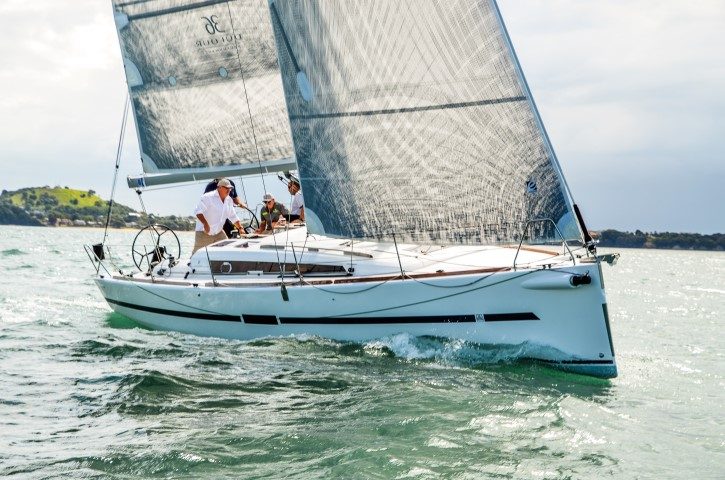
Sometimes the stars align – the weather, the time, the opportunity – they all finally coalesce into place. And there I was, fingers on the composite wheel gently guiding the yacht upwind at 6.2 knots in a warm 10–12 knot NE wind.
The tell-tales from the gorgeous Evolution sails streamed parallel, the Waitemata water flashed past, feet resting on the teak footstop, my eyes flicking down to the Raymarine speedo.
Everything was just right. Hard to define in words. The French have a saying “Je ne sais quoi” which literally translates to “I don’t know what” – but it really means an indefinable quality that makes something attractive.
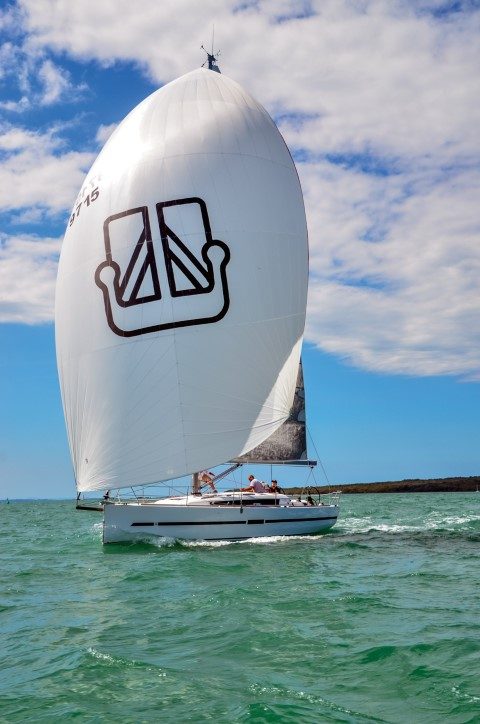
She’s been specifically designed for racing – that’s foremost – and a great example of this is the removable cockpit lockers which just expand the room available for the crew. It may seem a small touch, but when you add up all the design features of this new Dufour, you get something special.
Of course, Dufour has optimised this yacht for performance compared to the Dufour Grand Large 360. The design is from the board of Felci Yacht Design and is a completely new hull, longer on the waterline with an increased mast height, 28% more sail area with a deeper and heavier keel. A chine running aft from amidships gives increased stability when heeled.
She has a retractable prod for setting a code 0 or gennaker, with six Lewmar 40 winches to handle all the controls and sheets – all perfectly positioned for a round-the-buoys racing yacht.
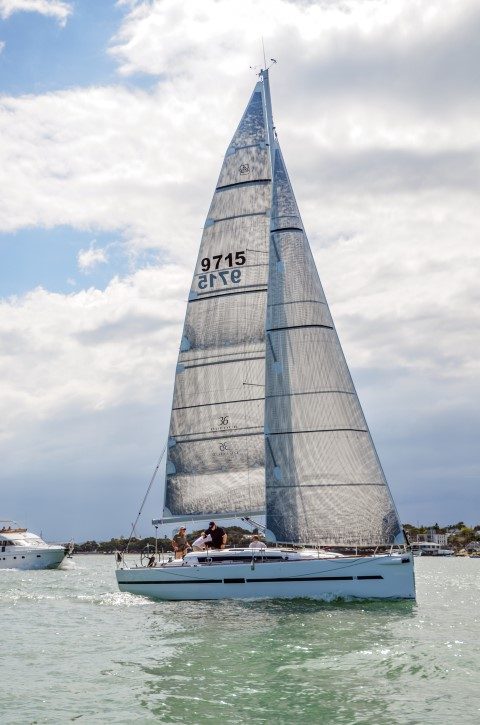
After beating our way towards Rangitoto it was time to set the furling gennaker and turn off the wind. Running deep to tension the halyard then unrolling the furler and sheeting on, she accelerated easily, rising to 7.5 knots. Still under fingertip control. A few waves under the stern quarter gave you the feeling that with a little more breeze she would want to get up and really go.
Sailing Experience
New Zealand’s Evolution built the sails – in Expedition cloth – for this yacht. The headsail is 108% overlapping sheeted to an adjustable side deck track leading back through turning blocks to the Lewmar 40 winches on the cockpit coaming.
The fully-battened mainsail, free-footed along the boom, has a German sheeting system, where the main sheet runs either side of the yacht and can be adjusted from the windward or leeward winches.
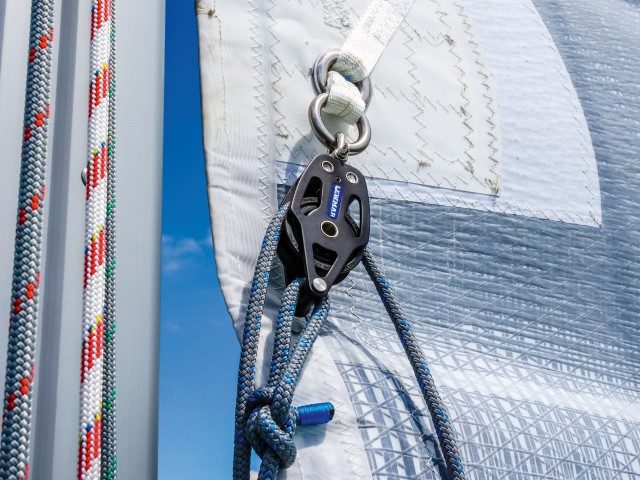
An adjustable traveller on the cockpit floor, just ahead of the twin composite wheels, takes of the mainsheet, with its control lines conveniently cleating on the sides of the cockpit. Attention to detail is clearly visible with nice chrome plates protecting the cabin top from sheet wear, where the mainsheet curves gently into the forward turning block.
Mast and boom are aluminium by Sparcraft, with Dyform standing rigging. The backstay has a 24-purchase system adjustable in two speeds.
All halyards and lines lead aft over covered cavities in the cabin top to jammers. All loose rope ends can conveniently be cascaded down into the cabin to the keep the cockpit working area free for action.
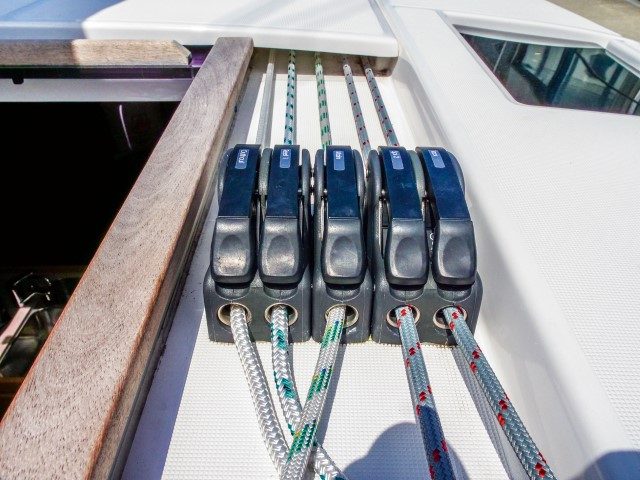
Twin helms are connected to the rudder with cables and each wheel has an angled pedestal bolted to the cockpit walls. This leaves the cockpit floor free from unnecessary protrusions and it feels ‘clean’. There are also excellent sightlines for sailing from helming at the side of the yacht.
Teak footrests on the cockpit floor offer the helmsman plenty of security – there are more on the floor centreline for the crew. I found this very useful sailing upwind as the boat’s sweet spot is at a good angle of heel. Also noticeable was the non-skid pattern in the deck moulding, which provided good grip.
Another nice touch was having all the hatches recessed into the deck moulding, leaving a flush surface. Nothing to catch that stray rope! A closer examination reveals the cleverly-integrated drainage channels for the recessed hatches.
No dodger was fitted to the yacht – perfect for her racing configuration. No doubt one can be retrofitted for cruising comfort.
Similarly, a bimini would be great for cruising – probably a collapsible model folding to the rear when sailing and deployed when at anchor, providing relief from the sun.
Cockpit
The cockpit is large by any standard, and with the option of removing the cockpit lockers the area really opens up for full-on racing. With cruising, the lockers provide two more comfortable seating positions.
The cockpit’s rear end lowers and transforms into a full-width duckboard. At her marina berth this makes for easy access, particularly when handling large sails and bags. A hinged, retractable boarding ladder facilitates swimming access. Also in the rear of the cockpit is a recess space for a life raft (to port), with a lazarette locker (starboard) through a floor hatch.
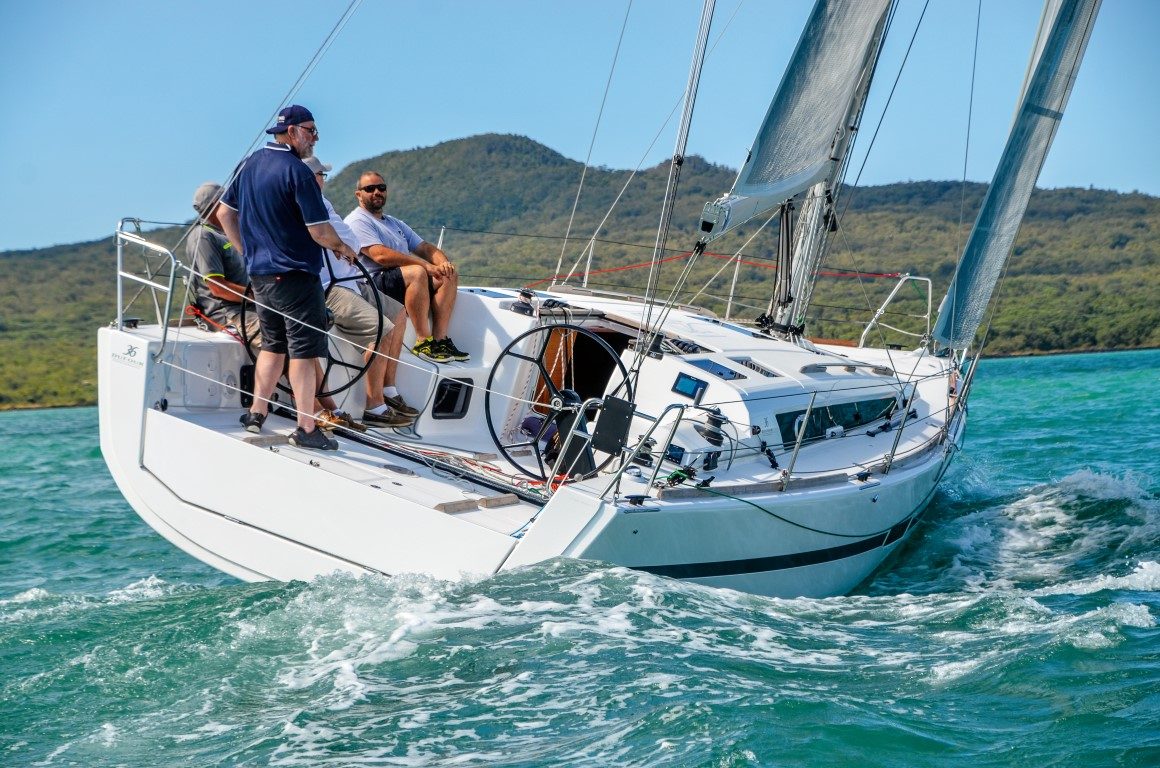
A self-draining locker for a small gas bottle is located on the port side aft.
As this is a racer/cruiser, instrumentation is important. Raymarine I70 displays are mounted at each helm, with a Raymarine eS75 multi-function display on the bulkhead. Wind data’s provided by a wired anemometer at the masthead. Also fitted is the Raymarine Evolution autopilot – a great cruising feature.
Layout
The Dufour 36 Performance is available in two layout options – two or three cabins.
This is the three-cabin version, with two double quarter berth cabins and a forward double cabin. The accommodation compromise with the three-cabin version is you lose a separate nav station, with the heads moving forward on the starboard side. All doubles have split squabs with the option of a pull-up divider, so the crew can rest without having to get too close to each other.
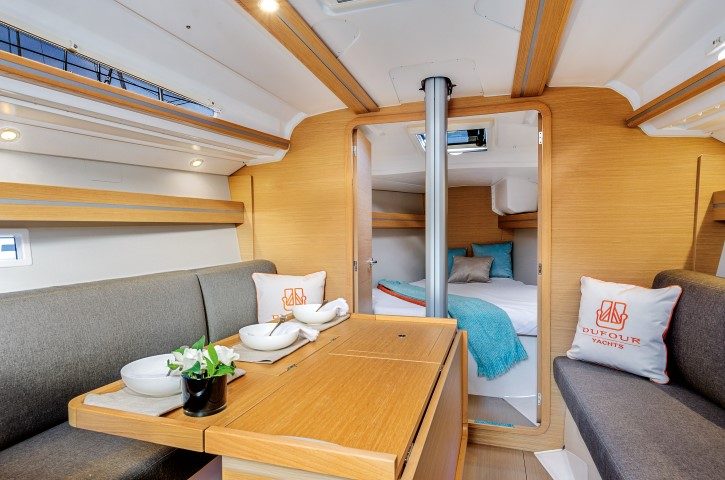
Access to the interior is easy via the four wide timber steps from the cockpit. The saloon is a bright airy space, with plenty of light flooding in through deck hatches and cabin/hull windows.
To port the L-shaped galley contains a very practical double sink arrangement, an electric fridge with a pull-up lid which cleverly stays open by itself to allow two-handed access to the contents. A two-burner stainless steel gas hob and oven caters for cooking. To starboard is the head, with a manual toilet, hand basin and shower.
Pride of place in the saloon area is a central island double leaf table with long settees either side. These could be used for additional sleeping berths for racing if lee cloths are fitted.
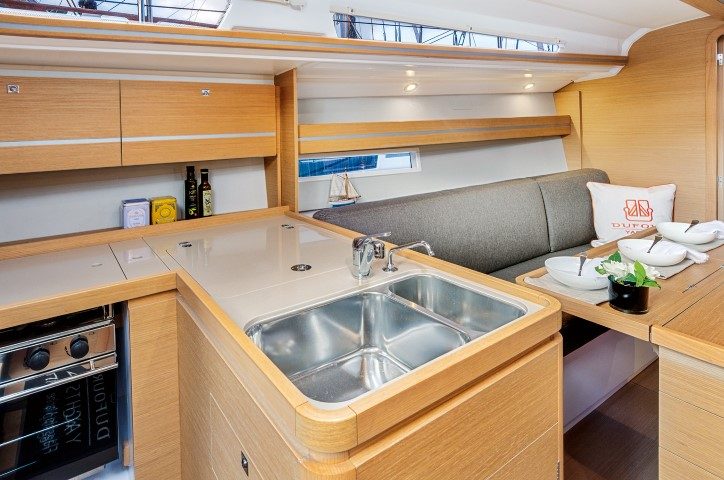
A double, opening door separates the forward cabin – with its good-sized double berth – from the main cabin. The oak finish exudes warmth and comfort – and attention to detail is faultless.
A 40hp Volvo Penta (standard engine is 29hp) with sail drive lives under the saloon entrance steps and easily pushed the streamlined hull along with a two-bladed folding propeller.
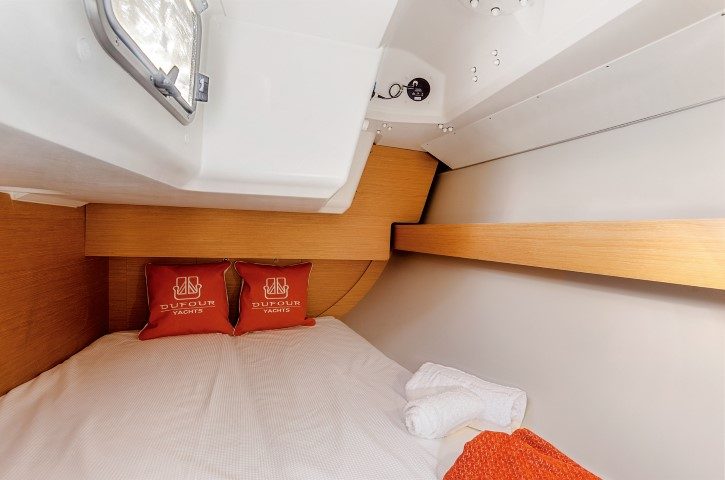
Options
As with most production yachts, a number of different options and packages are available to buyers.
Extras to the standard options included the electronics package, larger engine, the full winch upgrades and a number of upgraded sailing options such the Evolution package. This package features a gennaker, spinnaker and code 0.

Dufour yachts are imported by Auckland’s Flagship Marine – as tested, this 36 is worth $468,500.
Dufour and Felci Yacht Design have done a great job in executing the notoriously tricky design brief of producing a racer/cruiser that achieves both objectives.
This yacht really performs – and the light helm is a pleasure. Great sail control systems and a large, clear cockpit set this yacht apart, while down below the cruising comforts come with great internal ambience and finish.
Overall, something special indeed.
‘Behemoth’ is a word which springs to mind or, perhaps more nautically, ‘leviathan’.
White Pointer has earned the respect of discerning customers in New Zealand and Australia, attracting a loyal and ever growing following for its high-quality, rugged and totally dependable aluminium trailer boats.
The hardtop SP635 shares the same underpinnings as the popular SF 635 which was a completely new model back in 2020.
The pride and joy of a multi-generational family, Bliss resides on a pier that’s home to a couple of other Elite motor launches – Sandspit Marina is a hot-spot for the Bill Upfold-designed vessels, with several calling this small marina home.